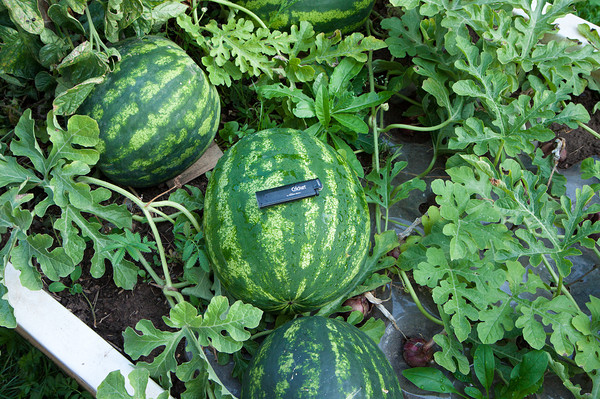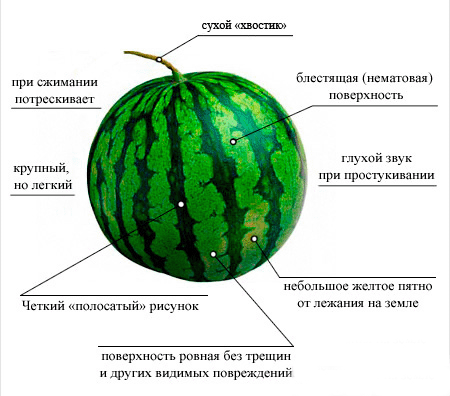How to accurately determine the ripeness of a watermelon
Summer is a huge assortment of berries, fruits and vegetables that can be eaten fresh directly from the garden. Watermelon is one of the brightest and most beloved berries of the summer season, because the juicy sugar pulp of watermelon is loved by adults and children. Watermelon juice perfectly refreshes on a hot summer day, quenches thirst and is a storehouse of vitamins: pectin and fiber, potassium and magnesium, folic acid and iron.
Content
How to understand that a watermelon is ripe
Most often, watermelons are consumed fresh, but today there are many recipes for successfully pickling and souring it in tubs. The watermelon rind becomes the basis for making candied fruits, and some craftsmen make honey from its juice. It is much easier to choose a ripe sugar watermelon in the garden than on a store counter. How to accurately determine the ripeness of a watermelon in the garden and in the store will be discussed in this article.
A fully ripe watermelon has the shape of a slightly elongated ball. If we talk about the weight of the finished product, then the berry should not be light and at the same time too heavy. The optimum weight of a ripe fruit is from 8 to 12 kg. Small watermelons will often be unripe. But when buying on the market, refrain from purchasing a watermelon whose weight is over 12 kg, since often such specimens are obtained as a result of abundant fertilization, which is not useful for humans. If we consider the ripening period of the berries, then the middle of August is the very milestone when the probability of buying a great sugar watermelon is highest. When choosing a ripe berry, it is necessary to be guided by several main visual indicators:
- spot on the side;
- The "bottom" of a watermelon;
- the appearance of the crust;
- condition of the tail;
- resonance of sound.
A small yellowish spot on the barrel of the berry is caused by contact with the ground. Its presence confirms the fact that the watermelon ripened in the garden, and was not plucked unripe for "comfortable" transportation. The color of the spot should be from yellow to dark orange, but a white tint or green indicates that the fruit is not ripe.
The watermelon is a bisexual berry, and therefore the gender of the watermelon matters. According to many consumers, the female fruit will be sweeter and have fewer seeds than the “boy”. Outwardly, the "girl" has a flatter lower part and a wider circle, and the "boys" are characterized by a lower part deepened inward and a very small circle.
Determined by the crust
Let's consider how to accurately determine the ripeness of a watermelon by its "clothes", that is, the peel. The watermelon rind should be free from cracks, spots or dents, and the rind is very hard to the touch. The fact is that as soon as the ripe fruit breaks off on its own from the branch, the flow of moisture to it stops, and the peel quickly hardens. If the watermelon is really "ready", then it will definitely not work to pierce it with a fingernail, but it is very easy to remove the thin top layer. Another sign of ripeness is the absence of a waxy coating on the peel, which shines beautifully in the sun.
Pay attention to the contrast of colors, how clearly the black-green stripes of the berry are visible. In the process of growth, he, like most plants, needs nutrients. Something is brought in by man, while others are given to the growing "organism" by nature itself. Chlorophyll is what makes the bark of the berry green and provides glucose.Once the fruit is ripe, chlorophyll production stops and the color slowly changes to yellow. Therefore, if the "combat" color of the berry is bright and contrasting, it means that during the growth process there was a lot of sun and heat, which is what the plant needs for comfortable development.
Video "Determine for sweetness and ripeness"
We distinguish ripeness by the tail
The ripeness of a watermelon can be determined by the tail. When the fruit reaches maturity, the stem (tail) and the place where it joins the fruit begin to dry out. A dry tail and dry edges of the stalk circle are a sure sign of a ripe watermelon. But very often melon is harvested unripe, so that it is more convenient to transport, especially over long distances. However, the tail should be moderately dry, as the overdried version indicates that the melon was harvested many weeks ago. The absence of a stalk, as a result of the seller's activities, suggests that the watermelon is definitely not ripe.
How to understand by sound
As you can see, it is not difficult to buy a ripe fruit if you carry out a careful visual inspection and "spank" it a little. The juicy berry will become a wonderful dessert on a summer day and will only benefit you and your household.
Can you tell by the sound of a ripe watermelon the seller offers you to buy? Of course you can, if you conduct a small experiment available to every buyer. It should resonate with the empty micro pockets in the sugar pulp of the fruit. To check if the specimen chosen for you resonates, place the berry on the palm of your left hand, and slap the fruit over the barrels with your right palm. So, a ripe berry passes the sound, and you will feel the return of your cotton in your left hand.
Video "How to determine ripeness"
To find out if this crop is ripe in your garden, we recommend watching the video clip that we have prepared especially for you.



